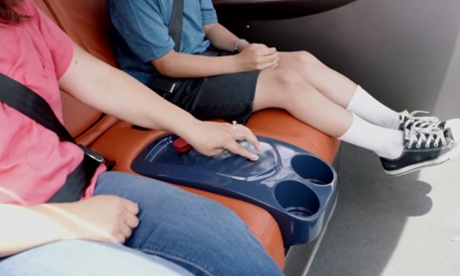Google building self-driving cars with no driver seat, steering wheels
Daily News Article — Posted on May 30, 2014
 (Reuters) – Google Inc is building cars that don’t have steering wheels, accelerator pedals or brake pedals, in an ambitious expansion of the Internet company’s efforts to develop self-driving cars.
(Reuters) – Google Inc is building cars that don’t have steering wheels, accelerator pedals or brake pedals, in an ambitious expansion of the Internet company’s efforts to develop self-driving cars.
The small electric cars, which seat two passengers, are currently prototypes that Google has been building through partnerships with automotive suppliers and manufacturers, Google co-founder Sergey Brin said at the Code conference in Southern California on Tuesday.
Google aims to build up to 200 such cars in the near term and hopes the vehicles will be available in various cities within a couple of years, he said.
Google has been testing self-driving cars since 2009, incorporating laser sensors and radars into standard automobiles such as the Prius from Toyota Motor Corp and sport-utility vehicles from Toyota luxury car division Lexus.
While those vehicles require a human to remain in the driver’s seat and to take over in certain situations, the new cars operate completely autonomously.
Brin said the cars could operate as a service, picking up passengers when summoned, and potentially even operate as fleets of interconnected “trains.”

The go button right next to the big red emergency stop button, just in case.
“Ten seconds after getting in I was doing my email, I had forgotten I was there,” Brin said of his experience riding in one of the pod-like vehicles, which resemble a cross between a Smart car and Volkswagen Beetle. “It ultimately reminded me of catching a chairlift.”
Brin declined to specify whether Google intended to build and sell the cars itself, saying only that the company would “work with partners.”
The driverless cars are currently limited to a maximum speed of 25 miles an hour, but Brin said there was no reason the cars could not go as fast as 100 miles an hour or more once they had been proven to be safe.
The front of the cars contain about 2 feet of foam and the windshield is made out of plastic instead of glass to make the cars safer, he said.
“Within a couple of years I hope we will surpass the safety metrics we’ve put in place, which is to be significantly safer than a human driver, and we will start testing them without drivers and hopefully you’ll be able to utilize them at some limited cities,” Brin said.
A handful of U.S. states, including California and Nevada, have passed legislation to allow testing of self-driving cars on public roads. Brin said he was optimistic that the new, passenger-only self-driving cars would be approved for testing in the U.S. and overseas in the future.
Reprinted here for educational purposes only. May not be reproduced on other websites without permission from Thomson Reuters. Visit the website at Reuters .com.
Background
- Google unveiled its prototypes of entirely autonomous cars on Tuesday, May 27th. The car drives completely through sensors and internal controls -- no steering wheel or brakes are accessible by passengers. This is a step away from Google’s previous self-driving car project, which featured the same controls seen on human-driven cars, but drove itself.
- Google says it is attempting the project to create a safer and more comfortable driving experience...
- “Ever since we started the Google self-driving car project, we’ve been working toward the goal of vehicles that can shoulder the entire burden of driving,” says Google self-driving car project director Chris Urmson in a blog post. “Just imagine: You can take a trip downtown at lunchtime without a 20-minute buffer to find parking. Seniors can keep their freedom even if they can’t keep their car keys. And drunk and distracted driving? History.”
- Google says the car...has sensors that can detect roadblocks, blind spots, and other objects over a distance of two football fields. Right now, the car’s speed is capped at 25 miles per hour and it is fully electric.
- Google invited reporters and several members of the public to take the cars on test rides in a secluded parking lot near its Mountain View, Calif. headquarters last week, and the reaction was generally positive. In a video made by Google, an elderly woman praises its textbook driving ability (it accelerates into turns, “just like I learned in driver’s ed,” she says) and a blind man says it would vastly improve his mobility.
- New York Times reporter John Markoff...questioned why exactly Google is pushing in this direction. Sergey Brin, Google’s co-founder, told him, “Regardless of Google, I think the right model for most of the world will be not through vehicle ownership. These should be provided as services for the most part.” (from a May 28 article at Christian Science Monitor)
